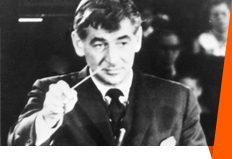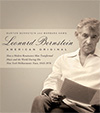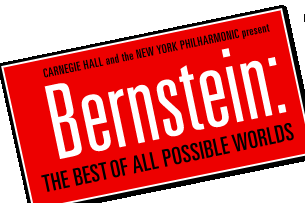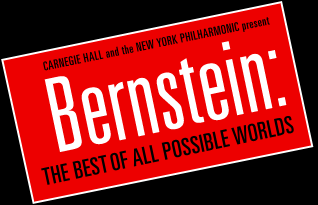
BERNSTEIN AND THE NEW YORK PHILHARMONIC
- Leonard Bernstein
- Stage & Film
- Concert Music
- The Conductor
- The Educator
- The Social Activist
- Bernstein’s New York
- Bernstein and Faith
- Bernstein at Carnegie Hall
- Bernstein and the New York Philharmonic
- Bernstein Memory Bank
- Bernstein Timeline
Video
Focus On
Leonard Bernstein and the New York Philharmonic
For nearly five decades Leonard Bernstein referred to the New York Philharmonic as his second family, leading the Orchestra in 1,246 performances—a number unmatched by any other Philharmonic conductor.
It all began on November 14, 1943, when Bernstein made his well-documented New York Philharmonic debut, which was broadcast live from coast to coast and which put him on the front page of the New York Times. Despite the ensuing acclaim, no one would have predicted that in 1958 a 40-year-old Bernstein would become the first American-born and trained music director of a major symphony orchestra. He held the post for 11 seasons and was then named Laureate Conductor, returning for frequent guest appearances.
Bernstein’s tenure as music director began when the Philharmonic still “lived” at Carnegie Hall, and he moved with the orchestra to Lincoln Center in 1962; however, through television and his more than 200 recordings with the Orchestra, he reached beyond the concert hall to touch the world. In particular, his 53 televised New York Philharmonic Young People’s Concerts inspired a love of music in a whole new generation. He also nurtured the next generation of conductors: among those who worked under his Philharmonic leadership were Seiji Ozawa, James DePreist, Sylvia Caduff, and Claudio Abbado.
Bernstein was a strong advocate of American composers. He gave the world premiere of Charles Ives’s Symphony No. 2 with the Philharmonic in 1951, 50 years after the work had been completed. He had a close, lifelong relationship with Aaron Copland, which included programming and recording nearly all of Copland’s orchestral works, devoting several televised Young People’s Concerts to him, and premiering Connotations, commissioned for the opening of Philharmonic Hall (now Avery Fisher Hall) at Lincoln Center.
While Bernstein’s repertoire encompassed the standard literature, he may be best remembered for his interpretations of Haydn, Beethoven, Brahms, Schumann, Sibelius, and Mahler. His particular identification with the last of these—and the sheer number of Philharmonic performances he programmed—was responsible for placing Mahler in the mainstream.
Bernstein led the Philharmonic on tours that spanned five continents. In 1958, during the Philharmonic’s first South American tour, he encountered then–Vice President Richard Nixon. The politician was booed and pelted with vegetables, while the musicians were cheered and revered. From there, nearly every tour abroad under Bernstein made a democratic political statement, including the Soviet Union in 1959, Japan in 1962, and Berlin in 1989. Bernstein used music to supersede hatred and fear, making his case for the betterment of the world.
Related Links
Support
Support Festivals at Carnegie Hall
Join Today! ![]()
Leonard Bernstein: American Original

By Burton Bernstein— former New Yorker writer and Leonard’s brother—and the New York Philharmonic’s historian, Barbara Haws.
Buy now ![]()
© 2001–2008 Carnegie Hall Corporation
- Home
- |
- Multimedia
- |
- Press
- |
- Partners
- |
- Supporters






